Transatlantic Tests 2 – Part 1
ARRL representative Paul Godley goes to Scotland
We start the story of the second series of Transatlantic Tests, scheduled for December 1921, with Paul Godley, at the age of 32, having set off on the Aquitania on 15 November, equipped with two state-of-the-art radio receivers and the hopes of the USA resting on his shoulders.
The second tests were scheduled to run from the evening of 7 December to the evening of the 16 December on the US side, corresponding to the mornings of 8 December to 17 on the UK side – ten successive nights. As with the first tests, the tests in December 1921 were purely West to East – US amateurs transmitting and the UK and other European amateurs listening. As with all the Tests, Fred Schnell, Traffic Manager for ARRL, coordinated activities for the ARRL and Philip Coursey for the Wireless Society of London (renamed RSGB in November 1922).
Meanwhile, W. Witt Burnham for the Wireless Society of London had taken up Warner’s bet of his Spring Hat, that if the ARRL were to send an amateur from the US over to England, with the latest radio technology, reception of US amateurs across the Atlantic would be achieved.
Tension was building in the weeks leading up to the tests as described in Wireless World, 26 November 1921.
Mr P F Godley, who is being sent over here by the American amateurs, will bring with him his own receiving equipment of a sufficiently flexible nature to cover the above-mentioned range of wavelengths, but obviously those American stations who are nearest to 200 metres on which wavelength most of us will be listening will have a better chance of getting through.[1]
The December 1921 QST cover featured an excellent drawing by 8ZZ with a globe labelled “Transatlantic Tests This Month” complete with lightning bolts linking North America to England. “QRM Babies” were bound to the north-pole spike to restrain them. In the USA, a radio amateur is keying his transmitter. In England an amateur is listening intently, through headphones fixed in place with a G-Cramp.
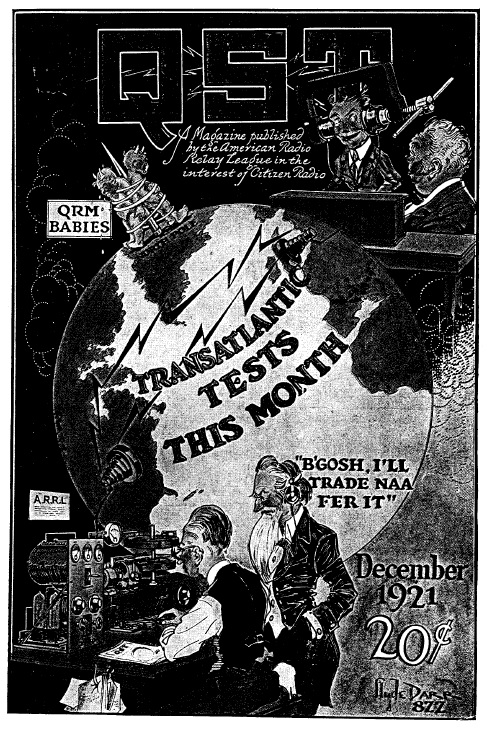
(Copyright ARRL, used with their kind permission)
In QST, February 1922 Godley provides a detailed report of his journey, including his coincidental meeting with Harold Beverage (of aerial fame) and later with Marconi.
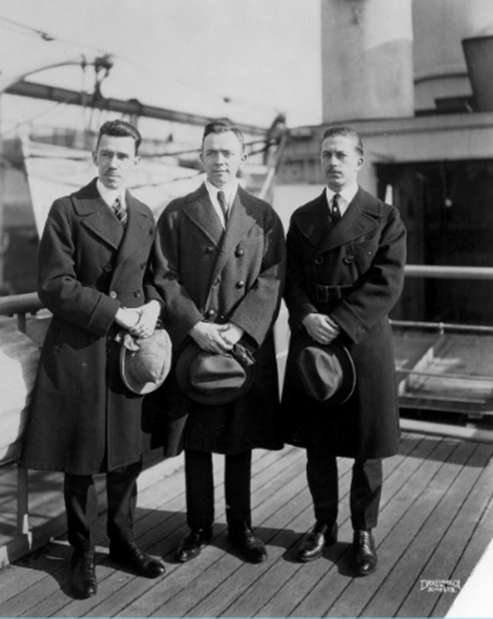
Paul Godley (centre) with ARRL’s, Kenneth Warner and Fred Schnell – farewell party on the Aquitania – copyright Bruce Littlefield, used with their kind permission
Official Report on the Second Transatlantic Tests
By Paul F. Godley
Who should I meet on the deck of the “Aquitania” as she left New York Harbor, but one H H Beverage, receiving engineer of the Radio Corporation of America, and by the way one who qualifies as being a “hard boiled ham.” Needless to say, I had not been with Beverage long before we got around to that thing which is nearest his heart, to wit, the Beverage wire, as a static reducer.
I finally reached London on a funny little train, and began to meet the various notables in and around London. I consider it of extreme fortune that it was possible for me to attend a meeting of the Wireless Society of London, and later to hear an extremely interesting lecture by Dr Fleming (inventer of the thermionic valve), at a meeting of the Royal Society of Arts.
At the close of Fleming’s lecture I met Marconi, who asked me to pass on to American amateurs his good wishes, for, he said: “I, too, am but an amateur!”
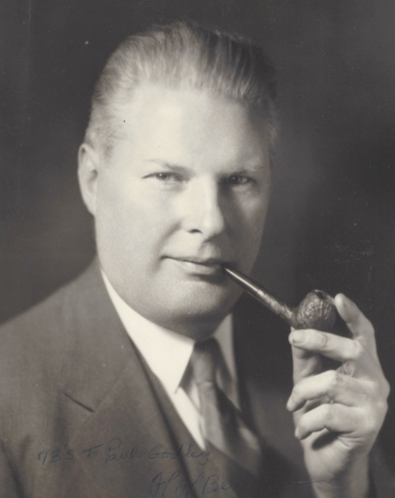
Signed photograph of Harold (Bev) Beverage “73’s to Paul Godley” – copyright Bruce Littlefield, used with their kind permission
Godley’s original intention had been to set up his receiving equipment in England; it is interesting to read his account of why and how he relocated to Ardrossan on the west coast of Scotland.
Preliminary arrangements for an operating permit had already been made by Coursey (his Wireless Society of London liaison) and two days after arriving in London I set up the regenerative receiver and super-heterodyne at the station of Commander Frank Phillips (in Wembley Park). British amateurs are very keen on radio frequency amplification. Phillips agreed that the Paragon regenerative combination gave signals somewhat better than those obtainable on the outfit he was using, and that it was a thing not to be lightly passed by.
The vast numbers of harmonics from single circuit tube transmitters and Poulsen arcs (a form of spark transmitter), which one picked up at all times, struck me forcibly. Atmospheric conditions, too, were of an unusual type. I have never before encountered anything like it.
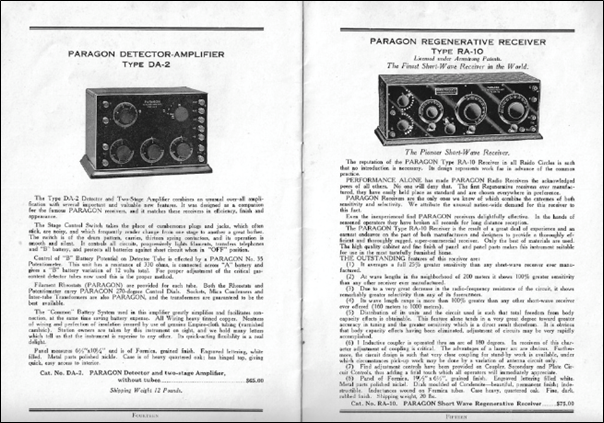
Paragon regenerative receiver Type-RA10 and detector amplifier Type DA-2 used by Paul Godley
Apart from the noisy receiving conditions in London, media pressure on Godley was building as evidenced in the London Star 30 November.
Last February’s tests were unsatisfactory from the point of view on both sides. In the States too many persons “tried their hands.” On this side, the delicate, finely-tuned instruments employed were interfered with by wireless novices using receivers which acted as miniature transmitters – drowning the feeble pulsations of American aerials. Americans, however, reject that excuse for our non-reception, declaring, that incompetence had a lot to do with it: and to make certain of really good reception this time they are sending over one of their hardest of “hardboiled hams” with a brand-new bag o’tricks and their good wishes. He will show us how it should be done.
What’s more, the heavy smog of 1920s London added to the list of reasons for Godley to adopt a “plan B” and relocate to Scotland.
During the entire first week in London everything was blanketed with heavy fog. On one morning in particular upon coming from the “Underground” onto the Strand, the fog and smoke was so thick that it was impossible to see more than twenty feet ahead.
Five nights of this sort of thing were quite enough. I was not at all at home under circumstances such as these and arranged accordingly to proceed to Scotland, having previously chosen Ardrossan as the location.
So, Godley packed up his equipment and boarded a train, initially for Aberdeen.
Immediately my decision to change locations became known, wild tales of all sorts began to come to me, concerning the terrible Scotch climate – the rains, the mists, the chill temperatures, to say nothing of the ill effects of the Scotch whisky which one would most certainly be unable to dodge. Even taking all of this with a good grain of salt, I was not sure that I looked forward to the trip into the “Scotch wilds” with any particular pleasure.
On Saturday evening Dec 3rd I arrived in Glasgow from Aberdeen.
Monday, December 5th, Central Station Hotel, Glasgow. Weather, 34 degrees (Fahrenheit) and overcast. No fog. Leave Glasgow 4 pm, Caledonia Railway for Ardrossan, arriving 5:30 pm (Eglinton Arms Hotel). Get large scale maps of Ardrossan, and try to choose likely site.
There remained but 30 hours before the tests commenced, and I was extremely anxious to locate that bit of ground upon which I might decide to erect the Beverage wire.
Although the tendency upon arrival was to sit tightly by the fire at the hotel, and bundle myself up, I went forth into the night in an effort to get the lay of the land.
The following morning further exploration was made in an effort to locate a suitable site. The north beach was once more explored, and then at this point we were caught in an unusually heavy downpour and soaked to the skin, but not until I had finally decided that a certain field upon which we had had our eye would be suitable for the set-up.
I had been congratulating myself all along on the good fortune of having two interpreters with me, because I must admit I found considerable difficulty in understanding English as spoken in Scotland.
At noon, Pearson, (who was to accompany Godley from the Marconi company), came on the scene, and we immediately began transferring huge bundles of tent, storage batteries, trunks, floor boards, poles for the antenna, etc., etc., on to this field. It proved to be a very slippery field. It had been covered almost entirely with a heavy coating of seaweed which is used as fertilizer; and those who have had experience in walking over seaweed know that it is a very difficult matter.
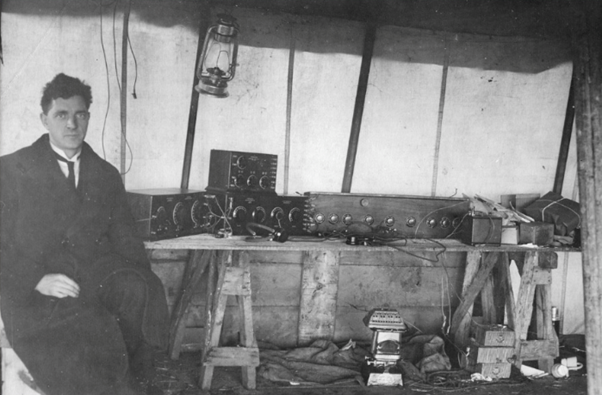
Mr. Pearson of Marconi Ltd seated in Paul Godley’s Ardrossan tent – copyright Bruce Littlefield, used with their kind permission
Godley goes on to describe the assembly of the equipment, his regenerative receiver and his super-heterodyne receiver, in a floor-boarded tent, plus the erection of a 1300 foot (400m) beverage wire aerial strung between 12 foot (3.5m) high poles. He continues..
My log for December 7th reads as follows:
Darkness finds poles up and wire strung. We continue work in light rain, and bury several ground plates in wet, sandy soil.
Returned to tent, fixed lead-in, and then to hotel for late supper. Procured coffee, sandwiches and a bottle before returning to tent. Made table of boards, and trestles, chairs were boxes and apparatus trunk served as a back rest. A lantern and oil stove were set going, and we made ourselves as comfortable as possible, though small stove did little by way of heating big tent. Tubes, apparatus, high tension battery and storage battery unpacked and found all OK after their long and varied journey through England and Scotland.
Still on the 7th…
By 11:30pm the 3,000 meter amplifier, which will be used throughout in conjunction with super-heterodyne receiver, was going and “FL” (Paris) was picked up with no antenna connection. In completing set-up, his time signals were missed but “POZ” (Nauen) at 12 midnight served as a check on timepieces. After time signals a 60-foot piece of wire was thrown into a tree for use in adjusting to short waves.
Picked up many, many 600-meter stations immediately it is connected, and, using them, go through and carefully adjust all apparatus for maximum sensitivity. By about 1 am we were on Beverage wire and feeling for short wave signals, and picking up harmonics from FL’s spark and many high power continuous wave stations, although harmonics much less severe than near London, with the exception of Clifden-Ireland’s, which are very strong.
At 1:33 am. picked up a 60-cycle synchronous spark at about 270 meters, chewing rag. Adjusted for him, and was able to hear him say “CUL” and sign off what we took to be 1AEP; but atmospherics made sign doubtful! That this was an American ham there was no doubt![2]
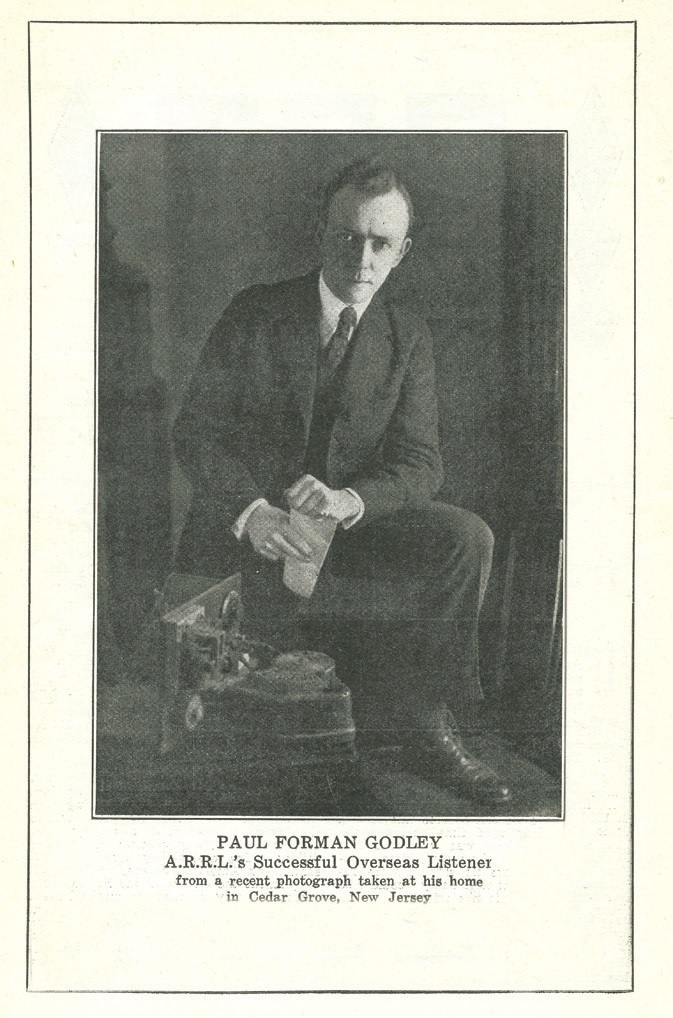
(Copyright ARRL, used with their kind permission)
So, Godley is ready for ten nights of listening, with some confidence of success. Our story continues on 8 December with the first night of the tests.
References
[1] The Transatlantic Tests, Wireless World, 26 November 1921, pp. 544-545
[2] Paul F Godley, Official Report of the Second Transatlantic Tests, QST, February 1922, pp. 14-28, 36-40, 46
Other pages in this section











